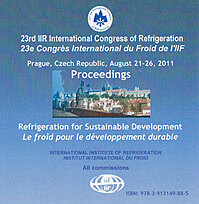
IIR document
Analysis of an active magnetic regenerator made of gadolinium wires.
Number: pap. ID: 324
Author(s) : VUARNOZ D., KAWANAMI T.
Summary
During the last century, the MagnetoCaloric Effect (MCE) has been widely used for realizing extremely low temperatures. However, it is only in the last three decades that some of the efforts to develop a benign and cutting-edge technology for realizing the MCE at temperatures around room temperature have been realized. The main component of magnetocaloric systems is the Active Magnetic Regenerator (AMR), but it is difficult to realize an optimum design for the AMR because of the poor mechanical properties of the MagnetoCaloric Materials (MCMs). In this study, an AMR configuration comprising a stack of gadolinium wires is investigated. A 1D physical model and a computer simulation program that can be used for studying the system are discussed in detail. The pressure drop, refrigeration capacity, and Coefficient Of Performance (COP) are numerically evaluated. Numerous simulation results obtained by using water as the working fluid for different regenerator geometries are discussed and optimal solutions are presented. These results are compared with those obtained for a configuration containing a bed of particles through which the working fluid flows.
Available documents
Format PDF
Pages: 8 p.
Available
Public price
20 €
Member price*
Free
* Best rate depending on membership category (see the detailed benefits of individual and corporate memberships).
Details
- Original title: Analysis of an active magnetic regenerator made of gadolinium wires.
- Record ID : 30002464
- Languages: English
- Source: Proceedings of the 23rd IIR International Congress of Refrigeration: Prague, Czech Republic, August 21-26, 2011. Overarching theme: Refrigeration for Sustainable Development.
- Publication date: 2011/08/21
Links
See other articles from the proceedings (569)
See the conference proceedings
-
Performance measurements on a large-scale magne...
- Author(s) : CHAUDRON J. B., MULLER C., HITTINGER M., et al.
- Date : 2018/09/16
- Languages : English
- Source: 8th International Conference on Caloric Cooling (Thermag VIII). Proceedings: Darmstadt, Germany, September 16-20, 2018.
- Formats : PDF
View record
-
Comprehensive study of heat transfer and pressu...
- Author(s) : KANG M., ELBEL S.
- Date : 2021/05
- Languages : English
- Source: 2021 Purdue Conferences. 18th International Refrigeration and Air-Conditioning Conference at Purdue.
- Formats : PDF
View record
-
The performance optimization of an active magne...
- Author(s) : YUAN L., QIAN S., YU J., et al.
- Date : 2017/07/20
- Languages : English
- Source: 8th international conference on compressors and refrigeration, 2017.
- Formats : PDF
View record
-
New magnetic refrigeration prototype with appli...
- Author(s) : MONFARED B., PALM B.
- Date : 2016/09/11
- Languages : English
- Source: 7th International Conference on Magnetic Refrigeration at Room Temperature (Thermag VII). Proceedings: Turin, Italy, September 11-14, 2016.
- Formats : PDF
View record
-
Numerical simulations and experimental tests of...
- Author(s) : NEVES BEZ E., NAKASHIMA A. T., LANG G. B., et al.
- Date : 2018/09/16
- Languages : English
- Source: 8th International Conference on Caloric Cooling (Thermag VIII). Proceedings: Darmstadt, Germany, September 16-20, 2018.
- Formats : PDF
View record
